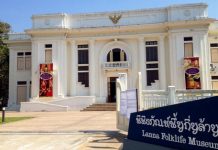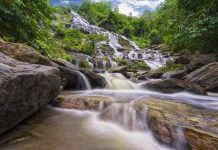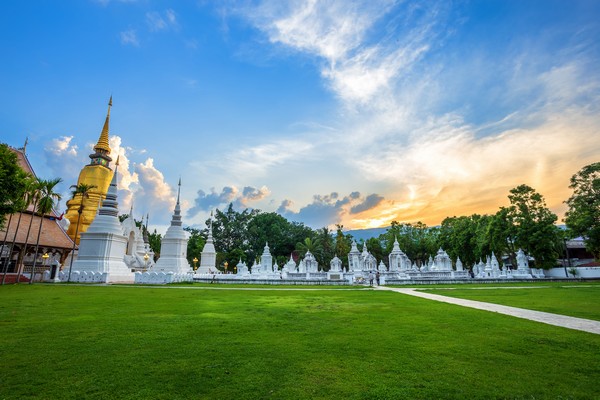
Wat Suan Dok, the royal mausoleums of Lanna Royalty
Wat Suan Dok where the place locates in the city town of Chaing Mai is one of the favorite attractions for the travelers who come to this historical city. Wat Suan Dok or literally Wat Buppharam which is Sanskrit means “Flower Garden” so that the villagers call the temple “Wat Suan Dok” which means the flower garden temple. The holy place was built in the reign of Phra Chao Gue Na Dhammikaraj the 6th king from the Mangrai house of the Lanna Kingdom.
The Importance of Wat Suan Dok
A compound is a spacious place with many sacred things, a 48 meters high Lanka pagoda that renovated and covered with Jangko Gold (the thin brass leaf that lacquered and covered with the gold leaf which is famous to use in covering the pagoda). Previously, the pagoda is Sukhothai style or lotus bud design; however, it was dilapidated. The pagoda is a house to enshrine the Buddha’s relics, and it already registered as the “national historical site,” as well. Day by day, numerous of the visitors come to the temple to worship this huge pagoda.
Next interesting site within the complex is a mausoleum which the ashes of Princess Dara Rasmi, a member of the royal family of Lanna, the consort of King Rama V. Also, the group of mausoleums of the rulers of Chiang Mai and members of the royal family of Lanna. Furthermore, the stupa to house the ashes of the famous Lanna Buddist monk “Khruba Sriwichai,” also here.
History of Wat Suan Dok
Wat Suan Dok was established within the “Wieng Suan Dok” complex which was the royal garden in the time of Mangrai Dynasty. In 1317 (as stated in a book “Chinna Kala Mali Pakon” by the venerable Buddhist monk “Rattana Panya Thera”) Phya Gue Na the 6th king of Mangrai Dynasty graciously commanded to establish “the royal monastery” by dedicating a royal garden that was filled with the Shorea trees (called Phayom in Thai) and named it as “Phayom Flower Garden”.
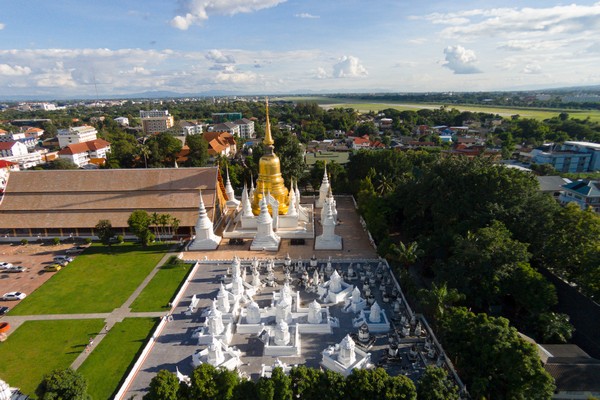
The royal monastery of which constructed with the purpose to be the dwelling for “Phra Maha Thera Sumon” the Buddhist monk who established the Buddhism Theravada sect in the Lanna Kingdom. Also, he was one who initiated to build the pagoda to enshrine one of those two “Buddha’s relics” that he respectful invited from the Sukhothai Kingdom in 1369 (another one said that enshrined inside the pagoda at “Wat Phra That Doi Suthep Ratcha Woravihara).
During the period of Mangrai Dynasty, it was a glory time of Wat Suan Dok, unfortunately after the end of the Mangrai Dynasty and the land was ruled over by Burma resulted in the disorder. Consequently, the temple was abandoned to be ruined. The compound, however, was restored in the reign of King Kawila the Thipchakrathiwong Dynasty (Jao Jed Ton), after that had been preserving by the northern royal family and the people of Chiang Mai from then on.
Wat Suan Dok has the remarkable restoration twice, first was in 1907 by Princess Dara Rasmi, the consort of King Rama V that she graciously ordered to collect the ashes of the late rulers of Chiang Mai and other members in the family to store in the same area. After that, the renovation was in 1932 by Khruba Sriwichai, the venerable Buddhist monk of Lanna.
The religious and sacred things at Wat Suan Dok
The Gigantic Lankan Pagoda
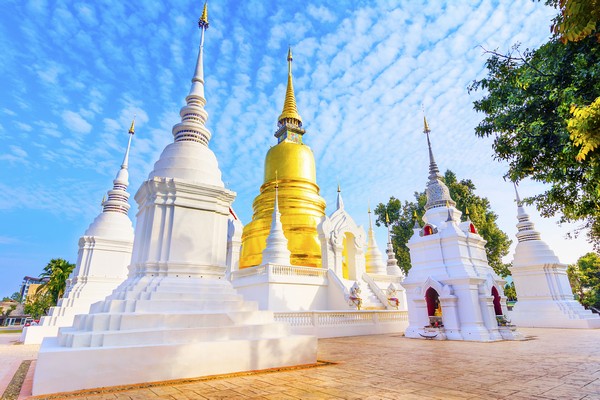
The great pagoda at Wat Suan Dok is repaired and covered with Jangko Gold. The original structure of the chedi was built in 1371 in the age of Phra Chao Gue Na, the 6th King of the Mangrai Dynasty. The ruler of the ancient Chiang Mai ordered to create “a Lankan pagoda” to enshrine the Buddha’s relics that “Phra Maha Thera Sumon” respectful invited from the Sukhothai Kingdom in 1369.
Formerly, the chedi which was in Sukhothai design (Phum Khao Bin) stood in the west of the great pagoda’s location, but it lied in ruins. The new pagoda was constructed in Ceylon style with 48 meters in its height and registered as the national historical site of Thailand announced in the government gazette volume 52 dated March 8, 1935.
Phra Chao Gao Tue
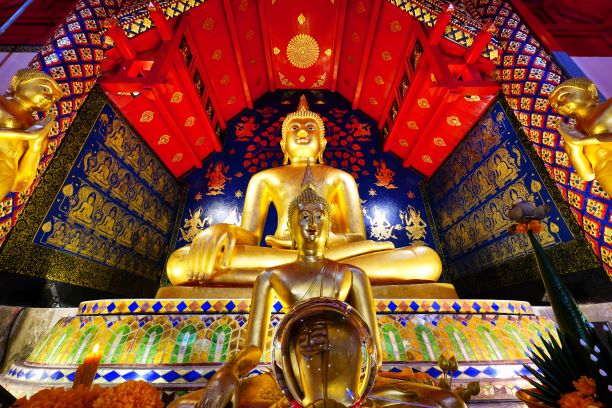
Phra Chao Gao Tue is an enormous Buddha statue which made from 9,000 kg of metal (the word “Tue” in northern Thai means thousand kilograms of weight). Phrya Muaeng Kaew, the 13th king of the Mangrai House, graciously ordered to built in 1504. Phra Chao Gao Tue is a Chiang Saen by the craftsmanship of Lanna and Sukhothai artisans. The important Buddha image is 3 meters wide on the lap and 4.7 meters high, initially, the image supposed to be housed at the main image at “Wat Phra Singh.”
However, the statue has weightily resulted to unfacilitated for transference; hence the king dedicated his villa to be the vihara (sanctuary) to house the Buddha statue and named the place “Wat Gao Tue.” And after the restoration by Khruba Sriwichai in 1932, the Department of Fine Arts registered the temple as the national historic site.
The word “Gao Tue” in northern Thai means: “Gao Tue” means 9 Tue weight of gold, the word “Tue” is the native Lanna language refers to measurement unit of gold in the ancient time. One Tue equals to 1,000 kg of gold, so Gao Tue (nine Tue) means 9,000 kg or 9 tons of gold.
“Phra Chao Gao Tue,” therefore is indeed the gigantic and magnificent Buddha image that the people of Lanna pooled effort to create the image to be the center of mind spirit and faith of the dwellers in that time.
Vihara Luang
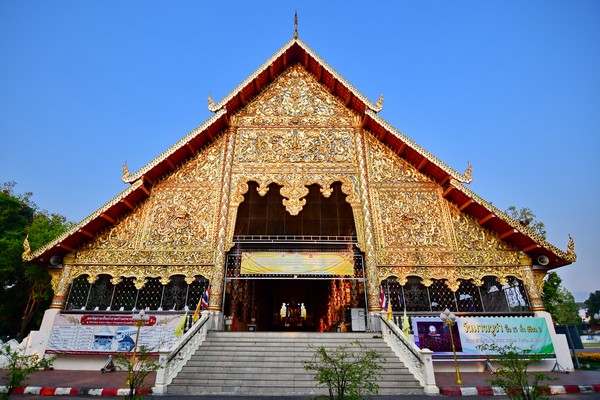
Inside the monastery complex, there is a vihara or a sanctuary which is unique from ones in other temples because it has no any wall but only the veranda around the building making it is proper ventilation. Both sides of the pediment decorated with the gorgeous fresco art in Lanna style.
The vihara is 24 meters wide and constructed in 1931 by Khruba Sriwichai. Inside the hall, there is a stucco figure of the Buddha in the attitude of subduing Mara together with the standing images in the rear and at the front finds a small Buddha image called “Phra Chao Kha King” stands which all enshrined inside the hall. Furthermore, the vihara of Wat Suan Dok is the largest royal sanctuary in Lanna, too.
Phra Buddha Patima Kha King
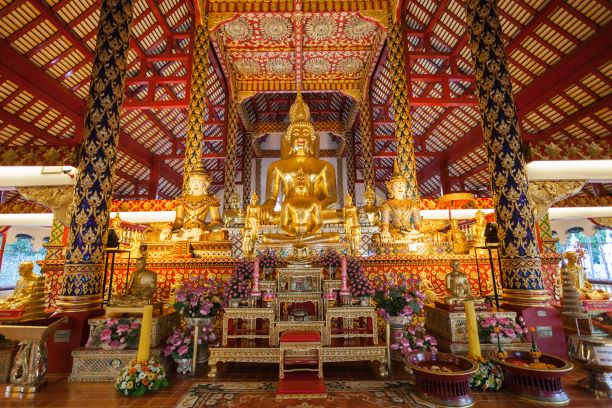
Phra Buddha Patima Kha King is a principle statue of the royal vihara which was created in the time of king Gue Na in 1373. The bronze Buddha image is said to be the same size of King Gue Na with 2 meters wide of the lap and 2.5 meters in its high and named followed the native language of Lanna “Phra Chao Kha King.”
Gu or the Mausoleums of the Northern Royal Family

The mausoleum of Princess Dara Rasmi, the consort of King Chulalongkorn (Rama V) of Siam
The group of the cemetery of the Lanna royal family constructed in 1907 by the initiative thought of Princess Dara Rasmi, the consort of King Rama V who is a member of the Lanna royalty (the family name “Na Chiang Mai). The princess considered that Wat Suan Dok is spacious compound; therefore, she collected the ashes of the former rulers of Chiang Mai and other members of the royalty to store in the place. Apart from that, Princess Dara Rasmi had donated to preserve the site all through her lifetime, also.
After the death of Princess Dara Rasmi, some part of her ashes invited to house at the mausoleum here and another part enshrined at the Royal Cemetery at Wat Ratchabophit Sathit Maha Simaram Ratcha Wora Maha Vihara in Bangkok). Today, the mausoleum is registered as one of the significant national historical sites under the administration of the Department of Fine Arts.
Owing to the temple is the location of the Northern Royalty cemetery; therefore, the place is considered to be the venue of the temporary crematorium to make the cremation ceremony for numbers of the royalty of Lanna namely;
- Princess Dara Rasmi, the consort of King Chulalongkorn (Rama V) of Siam on April 22, 1934
- Chao Ratchabut (Wongtawan Na Chiang Mai) the Prince Royal of Chiang Mai, on January 13, 1973
- Mom Srinuam Na Chiang Mai, the consort of Chao Wongtawan Na Chiang Mai, on January 18, 1992
- Chao Chai Suriyawong Na Chiang Mai, on August 30, 2004
- Khunying Chao Raweephan Sujaritkul, on July 8, 2015
Gu Khruba Sriwichai (The Stupa of Khruba Sriwichai)
A stupa to house the ashes of Khruba Sriwichai the most venerable Buddhist monk of Lanna. The stupa was built in 1947 in accordance to be a commemoration once the significant monk renovated the royal monastery and for the devotee to pay respect.
Dhammas Thesana (The Pulpit)
A Lanna style pulpit which made in 1931 together with three large door facades which designed in Lanna, as well. The platform created at the same time of renovation of the temple by Khruba Sriwichai.
General Information about Wat Suan Dok
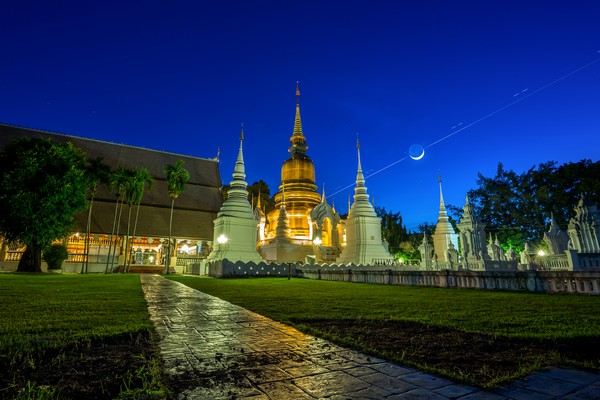
Operating Time:
Wat Suan Dok opens to the public from 8.00am through 5.00pm daily. However, the best time to take the picture is in the morning with no silhouette. And the site is an ideal place to visit all year round without any admission fee.
How to get to the Temple
By car:
From Chiang Mai city, drives along Suthep Road heading to Chiang Mai University and passes Maharaj Hospital. Wat Suan Dok is on the left side opposite of Dental Faculty. The parking is available at the temple.
By Public Transport:
The tourist can get on the Red Pick-up truck from anywhere in Chiang Mai town with the fee is THB20-30 per person/trip. Alternatively, the RTC bus number R3 that travels around the city. The price is THB20 per each for a trip (please prepare the exact amount because it is no changes). Then you can get off at the front of the temple.

